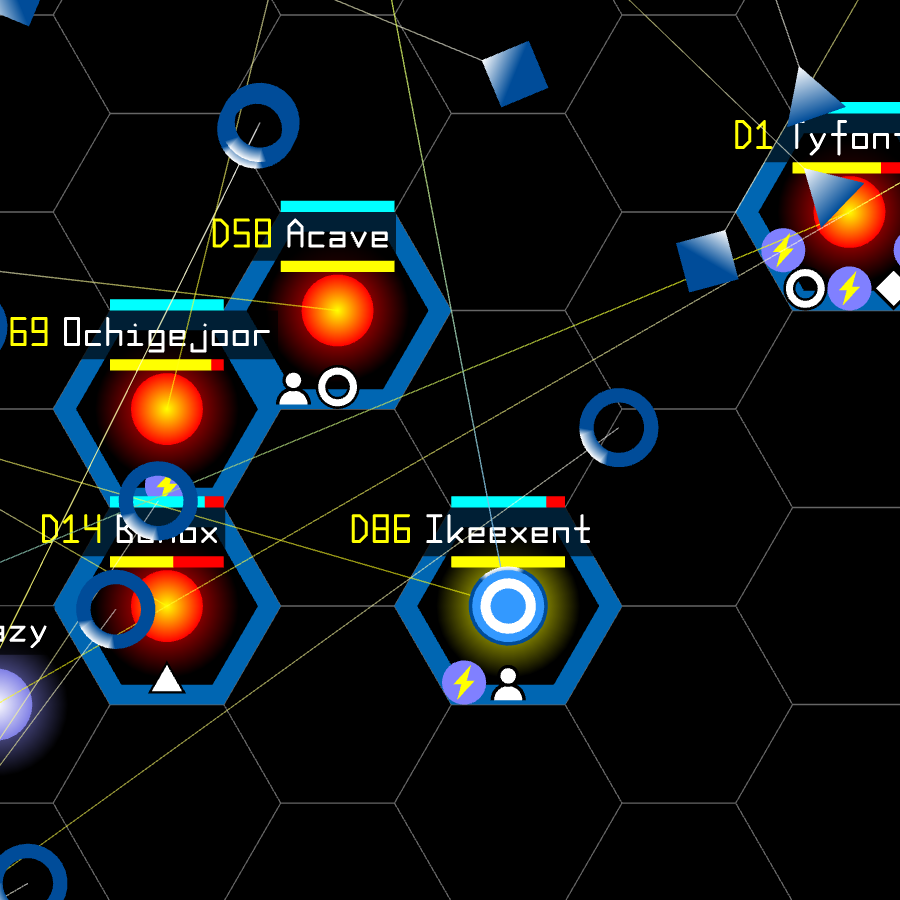New in Version 1.5
Version 1.5 is the most extensive expansion of the game to so far.
The biggest change is the concept of happiness and related to that: disasters and culture ships (no relation to the culture ships of Ian M. Banks).
Culture Ships

When they arrive in a system, they increase the happiness by 1. Provided that the happiness has not yet reached the highest value and the starting system has a higher happiness than the target system.
Furthermore, they increase the speed points in the destination system by 2 points. Provided the speed points do not yet have the highest value and the start system has a higher speed level than the destination system.
Disasters
Disasters reduce population, researched speed and happiness depending on the type and severity of the disaster.
There are 4 types of disasters, each of which is shown with a different colour on the map.
- Green: Biological disasters are plagues, famines and zombie apocalypses
- Red: Sociological disasters are conventional wars and nuclear wars
- Yellow: Geological disasters are earthquakes, seaquakes and supervolcano eruptions
- Blue: Cosmological disasters are asteroid impacts

Happiness
Each star system has a happiness ranging from 0 to 9.

When I write about unhappiness here, I mean the missing points to full happiness. So a happiness of 5 is equivalent to a unhappiness of 9 - 5 = 4.
Effects of happiness
Building, regeneration and scrapping time
The unhappiness is added to the building, regeneration and scrapping time in years. For example, if unhappiness is 4, the building time is extended by 4 years.
Strike
At a happiness of 1 or lower, the system goes on strike and no longer accepts orders.
Rebellion
A happiness of 0 causes the system to rebel and all stationed ships are destroyed. Culture and trade ships no longer have any effect. The system can be taken by the opponent without resistance. Normally the attacker loses one of his own battleships for each stationed battleship and one in addition. In the case of rebellion, no additional battleship is lost.
Euphoria
At 9 happiness, a system is euphoric. When euphoric systems are attacked, one of the attacker's battleships is destroyed without the system losing one. However, this only works once, because the happiness is lowered by 1 with every battle.
Disaster probability
Low happiness increases the probability of man-made disasters, which include all biological and sociological disasters.
Trade revenue
Trade revenue in the destination system is higher when happiness is high.
Causes of low happiness
Colonisation
A system has a happiness of 5 immediately after colonisation.
Battles
Each battle in the system reduces the happiness by 1.
Disasters
Disasters reduce happiness, population, speed points and stationed ships to varying degrees.
How can happiness be influenced
Culture ships
A culture ship increases the happiness by 1.
Throne ship
When the throne ship arrives in a system, the systems gets a happiness of 9. However, it can drop again due to attacks or disasters, even if the throne ship is still present.
Suppression of a rebellion
A system with 0 happiness rebels. The rebellion can only be ended by sending a battleship into the system. This increases the happiness to 1 because many unhappy rebels are killed. The disadvantage is that the population development is set back by 50 years.
Further Changes
Show more info on map
Show more info on the map so you don't have to go to the star info for it.
The speed level is now displayed for each system.
It is now shown on the map what the population is currently doing. Previously, you could only see the number of free population and the stationed ships as well as the ships under construction. Now the space is better used and the information about the population is more complete.

The system has a population of 5
1 builds a colony ship
1 maintains a trading ship
1 regenerates energy
1 scraps a culture ship
1 is free
Speed level is the same for all spectral types
All spectral types now have the same number of speed levels, which is 7.
Previously, the more common, cooler stars had more speed levels than the rarer, hot stars. The red stars had 13, the blue only 5.
For the cooler stars, it was hardly possible to explore the highest speed levels after the introduction of the disasters. The result was that games took too long overall. For the hotter stars, the highest speed was researched too quickly.
Throne ship has minimum speed of c/10
The throne ship starts with at least c/10. If the system is yours and the researched speed is higher, it starts with the researched speed.
Until now it was the case that it always started with the researched speed of the system, even if the system was in enemy hands.
That was illogical, why should your enemies help your throne ship? Therefore, the throne ship can now start without help if the system is not yours or the researched speed is too low.
Throne ship generates less debt with each journey
The formula is: travel distance * (25 - number of trips) debt. Reason: When the game is practically lost, you don't want it to drag on unnecessarily by shuttling between a few systems to generate debt.
Scrapping needs free population
Scrapping now needs free population. Related to this, scrapping also takes time. It just seems more logical to me that scrapping, just like building and starting, is done by a working population.
Regeneration formula changed
The longer the travel to which the ship starts, the longer the subsequent regeneration takes. Longer travels require more energy and besides the longer travel time, this is said to be another disadvantage when the ship sets off on a longer travel. Instead, the stars closer to the destination should be developed with the culture ship.